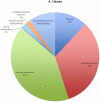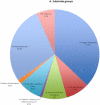Bioinformatic analyses of integral membrane transport proteins encoded within the genome of the planctomycetes species, Rhodopirellula baltica
- PMID: 23969110
- PMCID: PMC3905805
- DOI: 10.1016/j.bbamem.2013.08.007
Bioinformatic analyses of integral membrane transport proteins encoded within the genome of the planctomycetes species, Rhodopirellula baltica
Abstract
Rhodopirellula baltica (R. baltica) is a Planctomycete, known to have intracellular membranes. Because of its unusual cell structure and ecological significance, we have conducted comprehensive analyses of its transmembrane transport proteins. The complete proteome of R. baltica was screened against the Transporter Classification Database (TCDB) to identify recognizable integral membrane transport proteins. 342 proteins were identified with a high degree of confidence, and these fell into several different classes. R. baltica encodes in its genome channels (12%), secondary carriers (33%), and primary active transport proteins (41%) in addition to classes represented in smaller numbers. Relative to most non-marine bacteria, R. baltica possesses a larger number of sodium-dependent symporters but fewer proton-dependent symporters, and it has dimethylsulfoxide (DMSO) and trimethyl-amine-oxide (TMAO) reductases, consistent with its Na(+)-rich marine environment. R. baltica also possesses a Na(+)-translocating NADH:quinone dehydrogenase (Na(+)-NDH), a Na(+) efflux decarboxylase, two Na(+)-exporting ABC pumps, two Na(+)-translocating F-type ATPases, two Na(+):H(+) antiporters and two K(+):H(+) antiporters. Flagellar motility probably depends on the sodium electrochemical gradient. Surprisingly, R. baltica also has a complete set of H(+)-translocating electron transport complexes similar to those present in α-proteobacteria and eukaryotic mitochondria. The transport proteins identified proved to be typical of the bacterial domain with little or no indication of the presence of eukaryotic-type transporters. However, novel functionally uncharacterized multispanning membrane proteins were identified, some of which are found only in Rhodopirellula species, but others of which are widely distributed in bacteria. The analyses lead to predictions regarding the physiology, ecology and evolution of R. baltica.
Keywords: Cellular energization; Electron transport; Marine ecology; Planctomycetes; Sodium motive force; Transport proteins.
© 2013.
Figures









Similar articles
-
Cell surface proteome of the marine planctomycete Rhodopirellula baltica.Proteomics. 2012 Jun;12(11):1781-91. doi: 10.1002/pmic.201100512. Proteomics. 2012. PMID: 22623273
-
Permanent draft genomes of the three Rhodopirellula baltica strains SH28, SWK14 and WH47.Mar Genomics. 2014 Feb;13:13-4. doi: 10.1016/j.margen.2013.11.004. Epub 2013 Nov 25. Mar Genomics. 2014. PMID: 24286831
-
Evaluation of the phylogenetic position of the planctomycete 'Rhodopirellula baltica' SH 1 by means of concatenated ribosomal protein sequences, DNA-directed RNA polymerase subunit sequences and whole genome trees.Int J Syst Evol Microbiol. 2004 May;54(Pt 3):791-801. doi: 10.1099/ijs.0.02913-0. Int J Syst Evol Microbiol. 2004. PMID: 15143026
-
Determining the bacterial cell biology of Planctomycetes.Nat Commun. 2017 Apr 10;8:14853. doi: 10.1038/ncomms14853. Nat Commun. 2017. PMID: 28393831 Free PMC article. Review.
-
Na(+)-coupled alternative to H(+)-coupled primary transport systems in bacteria.Bioessays. 1991 Sep;13(9):463-8. doi: 10.1002/bies.950130906. Bioessays. 1991. PMID: 1665692 Review.
Cited by
-
Evolution of microbial dynamics with the introduction of real seawater portions in a low-strength feeding anammox process.Appl Microbiol Biotechnol. 2020 Jun;104(12):5593-5604. doi: 10.1007/s00253-020-10598-9. Epub 2020 Apr 17. Appl Microbiol Biotechnol. 2020. PMID: 32300855 Free PMC article.
-
Genomic data mining reveals a rich repertoire of transport proteins in Streptomyces.BMC Genomics. 2016 Aug 22;17 Suppl 7(Suppl 7):510. doi: 10.1186/s12864-016-2899-4. BMC Genomics. 2016. PMID: 27557108 Free PMC article.
-
Comparative genomics of the transportome of Ten Treponema species.Microb Pathog. 2019 Jul;132:87-99. doi: 10.1016/j.micpath.2019.04.034. Epub 2019 Apr 25. Microb Pathog. 2019. PMID: 31029716 Free PMC article.
-
TranCEP: Predicting the substrate class of transmembrane transport proteins using compositional, evolutionary, and positional information.PLoS One. 2020 Jan 14;15(1):e0227683. doi: 10.1371/journal.pone.0227683. eCollection 2020. PLoS One. 2020. PMID: 31935244 Free PMC article.
-
The transporter classification database.Nucleic Acids Res. 2014 Jan;42(Database issue):D251-8. doi: 10.1093/nar/gkt1097. Epub 2013 Nov 12. Nucleic Acids Res. 2014. PMID: 24225317 Free PMC article.
References
-
- Rabus R. An overview of 2D DIGE analysis of marine (environmental) bacteria. Methods Mol Biol. 2012;854:355–372. - PubMed
-
- Lindsay MR, Webb RI, Strous M, Jetten MS, Butler MK, Forde RJ, Fuerst JA. Cell compartmentalisation in planctomycetes: novel types of structural organisation for the bacterial cell. Arch Microbiol. 2001;175:413–429. - PubMed
-
- Lindsay MR, Webb RI, Fuerst JA. Pirellulosomes: a new type of membrane-bounded cell compartment in planctomycete bacteria of the genus Pirellula. Microbiology. 1997;143:739–748. - PubMed
Publication types
MeSH terms
Substances
Grants and funding
LinkOut - more resources
Full Text Sources
Other Literature Sources

